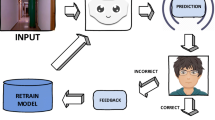Abstract
This paper describes a full navigation architecture which includes a set of available Deep Learning-based modules, focused on “speech to text” and “text to speech” translation, and face recognition, for enabling natural interaction between a smart mobile assistant robot and its human users, in a context of autonomous navigation. The system is novel because it allows complex spoken commands to be syntactically analyzed in Spanish and transformed into motion plans, ready to be executed by the robot, by using the well-known Navigation stack included in the ROS ecosystem. A novel computationally efficient approach (to semantically label the free space from raw data provided by a low cost laser scanner device), enables the generation of a labelled polygonal map, which enhances fixed and mobile obstacle avoidance and local planning in real indoor environments. Robot configuration, learned maps, and Deep Learning models adapted to each scenario are safely and privately stored in Google Cloud, allowing the robot to adapt its behavior to different users and settings. The tests which demonstrate the performance of the system, both in simulation and real environments, are also described.
Access this chapter
Tax calculation will be finalised at checkout
Purchases are for personal use only
Similar content being viewed by others
References
Miller, D.P.: Assistive robotics: an overview. In: Mittal, V.O., Yanco, H.A., Aronis, J., Simpson, R. (eds.) Assistive Technology and Artificial Intelligence, vol. 1458, pp. 126–136. Springer, Heidelberg (2006). https://doi.org/10.1007/BFb0055975
Brose, S.W., et al.: The role of assistive robotics in the lives of persons with disability. Am. J. Phys. Med. Rehabil. 89(6), 509–521 (2010)
Thrun, S., Burgard, W., Fox, D.: Probabilistic Robotics, Intelligent Robotics and Autonomous Agents Series. MIT Press, Cambridge (2006)
Tzafestas, S.G.: Mobile robot control and navigation: a global overview. J. Intell. Rob. Syst. 91(1), 35–58 (2018). https://doi.org/10.1007/s10846-018-0805-9
Ravankar, A., Ravankar, A.A., Kobayashi, Y., Hoshino, Y., Peng, C.-C.: Path smoothing techniques in robot navigation: state-of-the-art, current and future challenges. Sensors 18(9), 3170 (2018). https://doi.org/10.3390/s18093170
Chandra, R.: Precise localization for achieving next-generation autonomous navigation: State-of-the-art, taxonomy and future prospects. Comput. Commun. 160, 351–374 (2020). https://doi.org/10.1016/j.comcom.2020.06.007
Crespo, J., Castillo, J.C., Mozos, O.M., Barber, R.: Semantic information for robot navigation: a survey. Appl. Sci. 10(2), 497, 1–28 (2020). https://doi.org/10.3390/app10020497
Yasuda, Y.D.V., Martins, L.E.G., Cappabianco, F.A.M.: Autonomous visual navigation for mobile robots: a systematic literature review. ACM Comput. Surv. 53(1), 1–34 (2020). https://doi.org/10.1145/3368961
Zhu, K., Zhang, T.: Deep reinforcement learning based mobile robot navigation: a review. IEEE Tsinghua Sci. Technol. 26(5), 674–691 (2021). https://doi.org/10.26599/TST.2021.9010012
Shishehgar, M., Kerr, D., Blake, J.: A systematic review of research into how robotic technology can help older people. Smart Health. 7–8, 1–18 (2018). https://www.sciencedirect.com/science/article/pii/S2352648316300149
Tesla Autopilot. https://www.tesla.com/es_ES/autopilot. Accessed 12 Apr 2022
Vaussard, F., et al.: Lessons learned from robotic vacuum cleaners entering the home ecosystem. Robot. Auton. Syst. 62(3), 376–391 (2014). https://doi.org/10.1016/j.robot.2013.09.014
Robaczewski, A., Bouchard, J., Bouchard, K., Gaboury, S.: Socially assistive robots: the specific case of the NAO. Int. J. Soc. Robot. 13(4), 795–831 (2020). https://doi.org/10.1007/s12369-020-00664-7
Pandey, A.K., Gelin, R.: A mass-produced sociable humanoid robot: pepper: the first machine of its kind. IEEE Robot. Autom. Mag. 25(3), 40–48 (2018). https://doi.org/10.1109/MRA.2018.2833157
Këpuska, V., Bohouta, G.: Next-generation of virtual personal assistants (Microsoft Cortana, Apple Siri, Amazon Alexa and Google Home). In: Proceedings of IEEE 8th Annual Computing and Communication Workshop and Conference (CCWC), pp. 99–103. IEEE, Las Vegas (2018). https://doi.org/10.1109/CCWC.2018.8301638
Gil, H.: The elderly and the digital inclusion: a brief reference to the initiatives of the European Union and Portugal. MOJ Gerontol. Geriatr. 4(6), 213–221 (2019)
Beaunoyer, E., Dupéré, S., Guitton, M.J.: COVID-19 and digital inequalities: reciprocal impacts and mitigation strategies. Comput. Hum. Behav. 111 (2020). https://doi.org/10.1016/j.chb.2020.106424
AAL Programme. Ageing Well in the Digital World. http://www.aal-europe.eu/about/. Accessed 12 Apr 2022
engage. Enabling social robots. https://engage-aal-project.eu/. Accessed 12 Apr 2022
ReMember-Me. http://www.aal-europe.eu/projects/remember-me/. Accessed 12 Apr 2022
AgeWell. http://www.aal-europe.eu/projects/agewell/. Accessed 12 Apr 2022
eWare. http://www.aal-europe.eu/projects/eware/. Accessed 12 Apr 2022
CAMI. http://www.aal-europe.eu/projects/cami/. Accessed 12 Apr 2022
ASSAM. http://www.aal-europe.eu/projects/assam/. Accessed 12 Apr 2022
ExCITE. http://www.aal-europe.eu/projects/excite/. Accessed 12 Apr 2022
ALIAS. http://www.aal-europe.eu/projects/alias/. Accessed 12 Apr 2022
DOMEO. http://www.aal-europe.eu/projects/domeo/. Accessed 12 Apr 2022
Hannun, A., et al.: Deep speech: scaling up end-to-end speech recognition. arXiv:1412.5567 (2014). https://doi.org/10.48550/arXiv.1412.5567
DeepSpeech. https://github.com/mozilla/DeepSpeech. Accessed 15 Apr 2022
DeepSpeech-polyglot. https://gitlab.com/Jaco-Assistant/Scribosermo. Accessed 15 Apr 2022
Festival. https://www.cstr.ed.ac.uk/projects/festival/. Accessed 15 Apr 2022
CMU Flite. http://cmuflite.org/. Accessed 15 Apr 2022
Pico Text-to-Speech. https://www.openhab.org/addons/voice/picotts/. Accessed 15 Apr 2022
Text to Speech (TTS) library for Python 2 and 3, pyttsx3. https://pypi.org/project/pyttsx3/. Accessed 15 Apr 2022
Talkey Documentation. https://talkey.readthedocs.io/en/latest/. Accessed 15 Apr 2022
spaCy. https://spacy.io/. Accessed 15 Apr 2022
Schroff, F., Kalenichenko, D., Philbin, J.: FaceNet: a unified embedding for face recognition and clustering. In: Proceedings of the IEEE Computer Society Conference on Computer Vision and Pattern Recognition, pp. 815–823. IEEE. Boston (2015). https://doi.org/10.1109/CVPR.2015.7298682
Pavón, N., Ferruz, J., Ollero, A.: Describing the environment using semantic labelled polylines from 2D laser scanned raw data: application to autonomous navigation. In: Proceedings of IEEE/RSJ International Conference on Intelligent Robots and Systems (IROS2010), pp. 3257–3262, IEEE, Taipei (2010). https://doi.org/10.1109/IROS.2010.5650846
Pavon-Pulido, N., Lopez-Riquelme, J.A., Pinuaga-Cascales, J.J., Ferruz-Melero, J., Morais Dos Santos, R.: Cybi: a smart companion robot for elderly people: improving teleoperation and telepresence skills by combining cloud computing technologies and fuzzy logic. In: Proceedings of IEEE ICARSC, pp. 198–203, IEEE, Vila Real (2015). https://doi.org/10.1109/ICARSC.2015.40
Acknowledgements
This work has been partially supported by the project 21668/PDC/21 Program Proof of Concept included in the “Programa Séneca 2021” Region of Murcia, Spain.
Author information
Authors and Affiliations
Corresponding author
Editor information
Editors and Affiliations
Rights and permissions
Copyright information
© 2022 The Author(s), under exclusive license to Springer Nature Switzerland AG
About this paper
Cite this paper
Oterino-Bono, R. et al. (2022). Deep Learning Methods Integration for Improving Natural Interaction Between Humans and an Assistant Mobile Robot in the Context of Autonomous Navigation. In: Marreiros, G., Martins, B., Paiva, A., Ribeiro, B., Sardinha, A. (eds) Progress in Artificial Intelligence. EPIA 2022. Lecture Notes in Computer Science(), vol 13566. Springer, Cham. https://doi.org/10.1007/978-3-031-16474-3_44
Download citation
DOI: https://doi.org/10.1007/978-3-031-16474-3_44
Published:
Publisher Name: Springer, Cham
Print ISBN: 978-3-031-16473-6
Online ISBN: 978-3-031-16474-3
eBook Packages: Computer ScienceComputer Science (R0)




